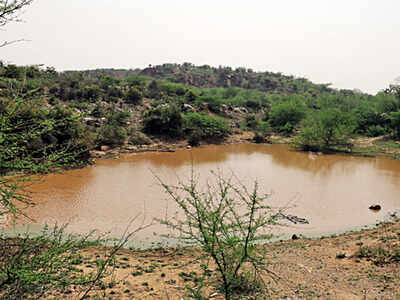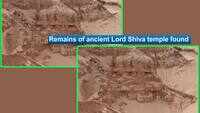
GURUGRAM : A term in revenue records that allowed hundreds of farmhouses backdoor entry into the Aravalis, and consequently large-scale construction on what was supposed to be protected land, has been removed after a long legal battle at multiple courts.
One of the legal forums was the National Green Tribunal, which begun hearings after taking suo motu cognisance of a January 7, 2013 TOI report, titled, ‘How private players grabbed forest land in the Aravalis’.
Acting on the directions of the NGT, the Gurugram administration has replaced the term ‘gair mumkin farmhouse’, which had insidiously found its way into the revenue records and helped farmhouse owners skirt provisions of the Aravli Notification that came into force in 1992, with the original term, ‘gair mumkin pahad’ (uncultivable hill).
Under the Union environment ministry’s Aravali Notification, ‘gair mumkin pahad’ is protected land where construction of buildings, roads, electrification and cutting of trees is not permitted.
The change in the revenue records removes the shield farmhouses had despite being illegally built. It will, however, have no impact on the land’s ownership. What it will do, though, is bring all this land unequivocally under clauses of the Aravali Notification and disallow any ‘non-forest’ activity. It will also deter new construction.
A forest department officer said the action can now be initiated against existing farmhouses. “The revenue department has already submitted its rectified documents to the NGT. The farmhouses which were built after 1992 will be demolished. Notices have already been served to them,” the officer said. According to the forest department, there are around 1,500 acres of land in the ‘gair mumkin farmhouse’ category in revenue records, a significant portion of which is in Raisina.
“The Aravali hills classified as gair mumkin pahad are village common lands and have been privatised and sought to be fragmented in Raisina hills. This NGT order closes the door on the dreams of construction in the Aravali hills,” said Chetan Agarwal, an environment analyst. “The land owners of the gair mumkin pahad areas can manage the land jointly once the buildings are removed and the land is restored as forest. This would save the large expenses that people make at an individual level to manage their 1-2 acres. The 1,200-acre Aravali Retreat falls on the leopard corridor between Asola Bhatti sanctuary and Sariska and has the potential to become a wonderful sanctuary, an eco-tourism hotspot and could even recover the operational costs.”
The NGT, in the latest in a string of directions, had on March 17 this year ordered the forest department, Haryana State Pollution Control Board and Gurugram administration to finalise the list of areas under Aravali Notification and submit an action-taken report by June 19. The Gurugram revenue officer was subsequently directed by the administration to follow the NGT order of 2018 in the Soniya Ghosh vs State of Haryana case.
The judgment in the case, whose hearings had originally begun with the court taking note of the TOI report of 2013, came in October 2018. It said, “Construction on forest land or area covered by Aravali Notification is illegal, and such forest land has to be restored… any construction raised on the forest area or the area otherwise covered by notification dated 07.05.1992 without permission of the competent authority (after the date of the said notification) has to be treated as illegal and such forest land has to be restored,” the NGT had ruled.
NGT gave two months to the Haryana government to set up a committee, and three months to identify all forest land covered by the Aravali Notification. The committee was, however, set up only in July 2019. Demolition notices were issued to farmhouses but in many cases, there was no actual demolition.
During the course of the hearing, in 2014, when the NGT had asked the Gurugram administration to submit reasons why demolition was not conducted, an affidavit submitted by the district town planner stated, “Ready to demolish over 150 buildings on two dates, but could not get police force.”
Environmentalists said the correction in revenue records was long overdue and demolition of farmhouses is the second step. “The NGT has given a clear direction that construction in forest land and Aravali Notification areas is illegal after the date of notification and it has ordered that the forest land be restored. The district administrations of Gurgaon and Faridabad must remove all constructions and hand over the land to the forest department for restoration,” said Lt Col Sarvadaman Singh Oberoi (retd), an environmentalist.
Gurugram deputy commissioner Amit Khatri did not respond to requests for a comment.
One of the legal forums was the National Green Tribunal, which begun hearings after taking suo motu cognisance of a January 7, 2013 TOI report, titled, ‘How private players grabbed forest land in the Aravalis’.
Acting on the directions of the NGT, the Gurugram administration has replaced the term ‘gair mumkin farmhouse’, which had insidiously found its way into the revenue records and helped farmhouse owners skirt provisions of the Aravli Notification that came into force in 1992, with the original term, ‘gair mumkin pahad’ (uncultivable hill).
Under the Union environment ministry’s Aravali Notification, ‘gair mumkin pahad’ is protected land where construction of buildings, roads, electrification and cutting of trees is not permitted.
The change in the revenue records removes the shield farmhouses had despite being illegally built. It will, however, have no impact on the land’s ownership. What it will do, though, is bring all this land unequivocally under clauses of the Aravali Notification and disallow any ‘non-forest’ activity. It will also deter new construction.
A forest department officer said the action can now be initiated against existing farmhouses. “The revenue department has already submitted its rectified documents to the NGT. The farmhouses which were built after 1992 will be demolished. Notices have already been served to them,” the officer said. According to the forest department, there are around 1,500 acres of land in the ‘gair mumkin farmhouse’ category in revenue records, a significant portion of which is in Raisina.
“The Aravali hills classified as gair mumkin pahad are village common lands and have been privatised and sought to be fragmented in Raisina hills. This NGT order closes the door on the dreams of construction in the Aravali hills,” said Chetan Agarwal, an environment analyst. “The land owners of the gair mumkin pahad areas can manage the land jointly once the buildings are removed and the land is restored as forest. This would save the large expenses that people make at an individual level to manage their 1-2 acres. The 1,200-acre Aravali Retreat falls on the leopard corridor between Asola Bhatti sanctuary and Sariska and has the potential to become a wonderful sanctuary, an eco-tourism hotspot and could even recover the operational costs.”
The NGT, in the latest in a string of directions, had on March 17 this year ordered the forest department, Haryana State Pollution Control Board and Gurugram administration to finalise the list of areas under Aravali Notification and submit an action-taken report by June 19. The Gurugram revenue officer was subsequently directed by the administration to follow the NGT order of 2018 in the Soniya Ghosh vs State of Haryana case.
The judgment in the case, whose hearings had originally begun with the court taking note of the TOI report of 2013, came in October 2018. It said, “Construction on forest land or area covered by Aravali Notification is illegal, and such forest land has to be restored… any construction raised on the forest area or the area otherwise covered by notification dated 07.05.1992 without permission of the competent authority (after the date of the said notification) has to be treated as illegal and such forest land has to be restored,” the NGT had ruled.
NGT gave two months to the Haryana government to set up a committee, and three months to identify all forest land covered by the Aravali Notification. The committee was, however, set up only in July 2019. Demolition notices were issued to farmhouses but in many cases, there was no actual demolition.
During the course of the hearing, in 2014, when the NGT had asked the Gurugram administration to submit reasons why demolition was not conducted, an affidavit submitted by the district town planner stated, “Ready to demolish over 150 buildings on two dates, but could not get police force.”
Environmentalists said the correction in revenue records was long overdue and demolition of farmhouses is the second step. “The NGT has given a clear direction that construction in forest land and Aravali Notification areas is illegal after the date of notification and it has ordered that the forest land be restored. The district administrations of Gurgaon and Faridabad must remove all constructions and hand over the land to the forest department for restoration,” said Lt Col Sarvadaman Singh Oberoi (retd), an environmentalist.
Gurugram deputy commissioner Amit Khatri did not respond to requests for a comment.

Coronavirus outbreak
Trending Topics
LATEST VIDEOS
City
 UP: Woman gang-raped in bus on the way to GautamBuddha Nagar from Pratapgarh, 1 arrested
UP: Woman gang-raped in bus on the way to GautamBuddha Nagar from Pratapgarh, 1 arrested  5-star Taj Mansingh in the heart of Lutyens' Delhi to become Covid-19 facility, five more hotels named
5-star Taj Mansingh in the heart of Lutyens' Delhi to become Covid-19 facility, five more hotels named  India-China clash at LAC: 'Boycott Chinese products' chorus grows, massive protests outside Chinese Embassy in Delhi
India-China clash at LAC: 'Boycott Chinese products' chorus grows, massive protests outside Chinese Embassy in Delhi  Andhra Pradesh: Remains of ancient Lord Shiva temple found during sand mining process in Nellore
Andhra Pradesh: Remains of ancient Lord Shiva temple found during sand mining process in Nellore
More from TOI
Navbharat Times
Featured Today in Travel
Quick Links
Kerala Coronavirus Helpline NumberHaryana Coronavirus Helpline NumberUP Coronavirus Helpline NumberBareilly NewsBhopal NewsCoronavirus in DelhiCoronavirus in HyderabadCoronavirus in IndiaCoronavirus symptomsCoronavirusRajasthan Coronavirus Helpline NumberAditya ThackerayShiv SenaFire in MumbaiAP Coronavirus Helpline NumberArvind KejriwalJammu Kashmir Coronavirus Helpline NumberSrinagar encounter
Get the app



